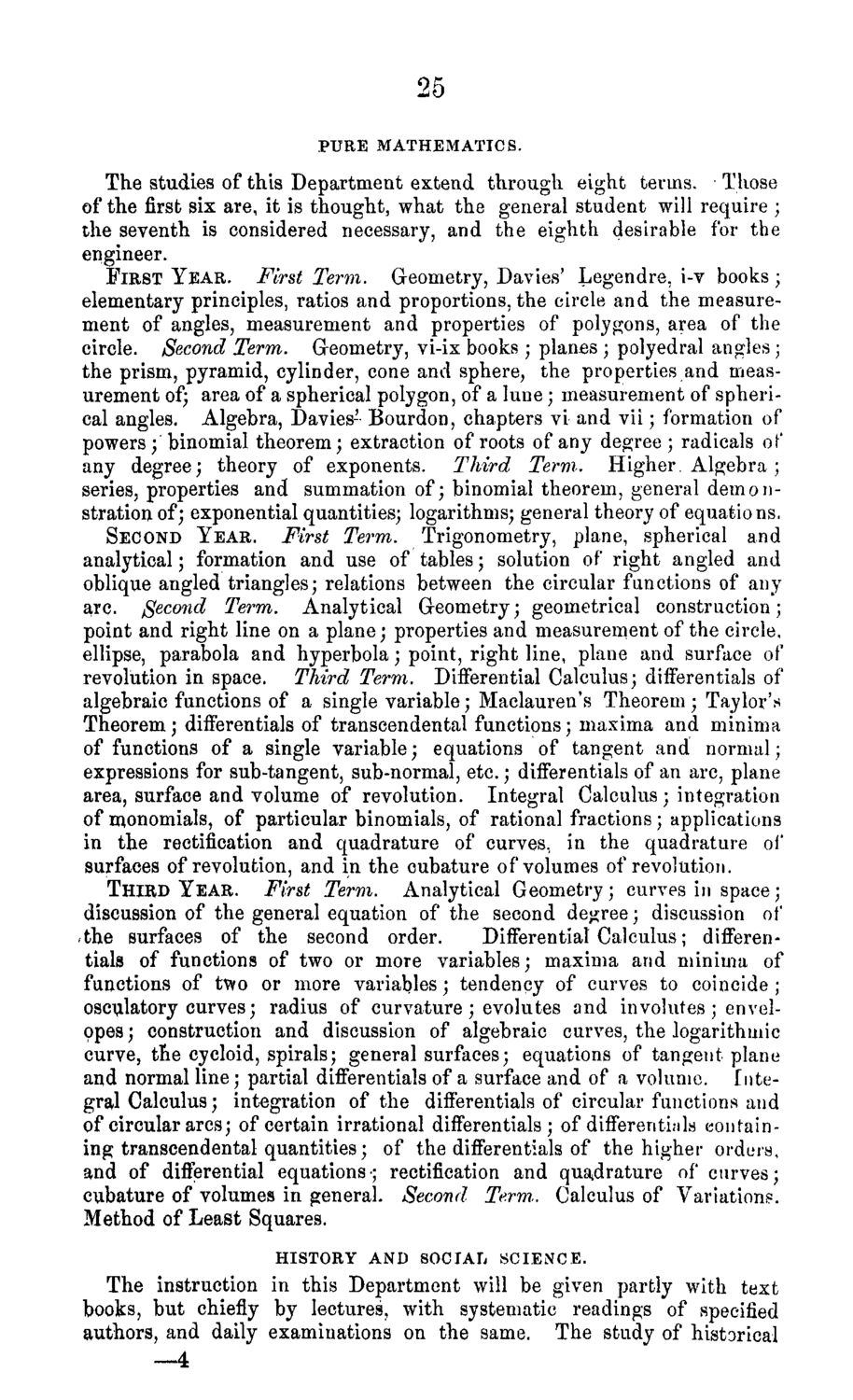| |
| |
Caption: Course Catalog - 1870-1871
This is a reduced-resolution page image for fast online browsing.

EXTRACTED TEXT FROM PAGE:
25 PUKE MATHEMATICS. The studies of this Department extend through eight terms. Those of the first six are, it is thought, what the general student will require ; the seventh is considered necessary, and the eighth desirable for the engineer. FIRST YEAR. First Term. Geometry, Davies' Legendre, i-v books ; elementary principles, ratios and proportions, the circle and the measurement of angles, measurement and properties of polygons, area of the circle. Second Term. Geometry, vi-ix books ; planes ; polyedral angles ; the prism, pyramid, cylinder, cone and sphere, the properties and measurement of; area of a spherical polygon, of a lune; measurement of spherical angles. Algebra, Davies- Bourdon, chapters vi and vii; formation of powers; binomial theorem; extraction of roots of any degree; radicals of any degree; theory of exponents. Third Term. Higher. Algebra ; series, properties and summation of; binomial theorem, general demonstration of; exponential quantities; logarithms; general theory of equations. SECOND YEAR. First Term. Trigonometry, plane, spherical and analytical; formation and use of tables; solution of right angled and oblique angled triangles; relations between the circular functions of any arc. Second Term. Analytical Geometry; geometrical construction; point and right line on a plane; properties and measurement of the circle, ellipse, parabola and hyperbola; point, right line, plane and surface of revolution in space. Third Term. Differential Calculus; differentials of algebraic functions of a single variable; Maclauren's Theorem ; Taylor's Theorem; differentials of transcendental functions; maxima and minima of functions of a single variable; equations of tangent and normal; expressions for sub-tangent, sub-normal, etc.; differentials of an arc, plane area, surface and volume of revolution. Integral Calculus ; integration of monomials, of particular binomials, of rational fractions; applications in the rectification and quadrature of curves, in the quadrature of surfaces of revolution, and in the cubature of volumes of revolution. THIRD YEAR. First Term. Analytical Geometry; curves in space; discussion of the general equation of the second degree; discussion of the surfaces of the second order. Differential Calculus; differentials of functions of two or more variables; maxima and minima of functions of two or more variables; tendency of curves to coincide; osculatory curves; radius of curvature ; evolutes and involutes; envelopes ; construction and discussion of algebraic curves, the logarithmic curve, the cycloid, spirals; general surfaces; equations of tangent plane and normal line; partial differentials of a surface and of a volume. Integral Calculus; integration of the differentials of circular functions and of circular arcs; of certain irrational differentials; of differenti.-ils containing transcendental quantities; of the differentials of the higher orders, and of differential equations-; rectification and quadrature of curves; cubature of volumes in general. Second. Term,. Calculus of Variations. Method of Least Squares. HISTORY AND SOCIAL SCIENCE. The instruction in this Department will be given partly with text books, but chiefly by lectures, with systematic readings of specified authors, and daily examinations on the same. The study of historical —4
| |